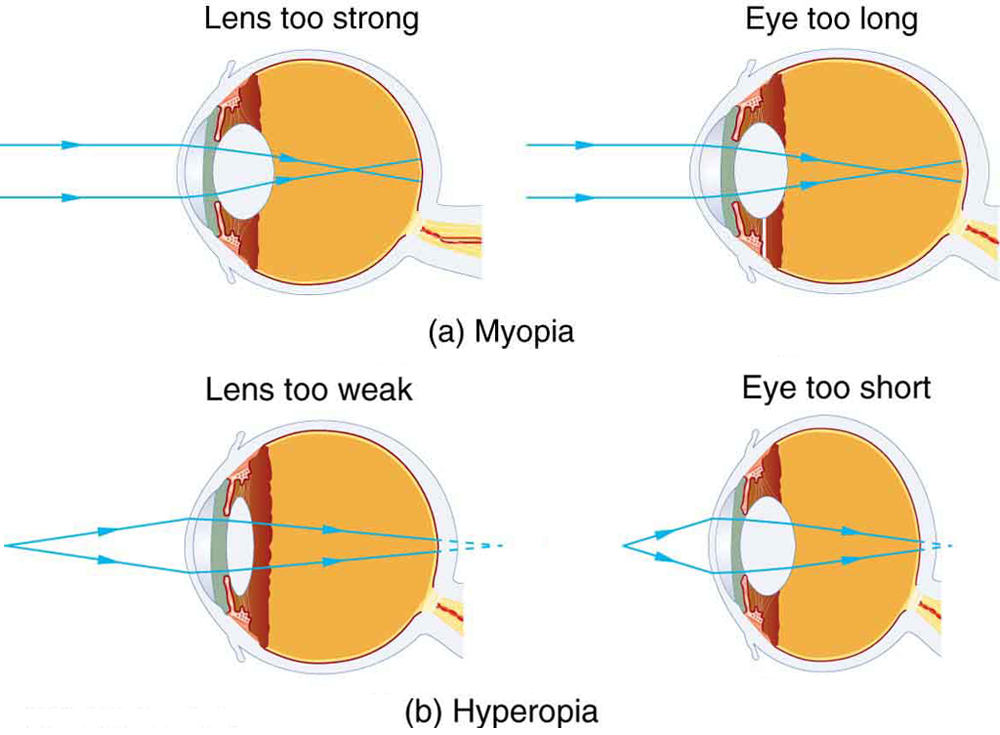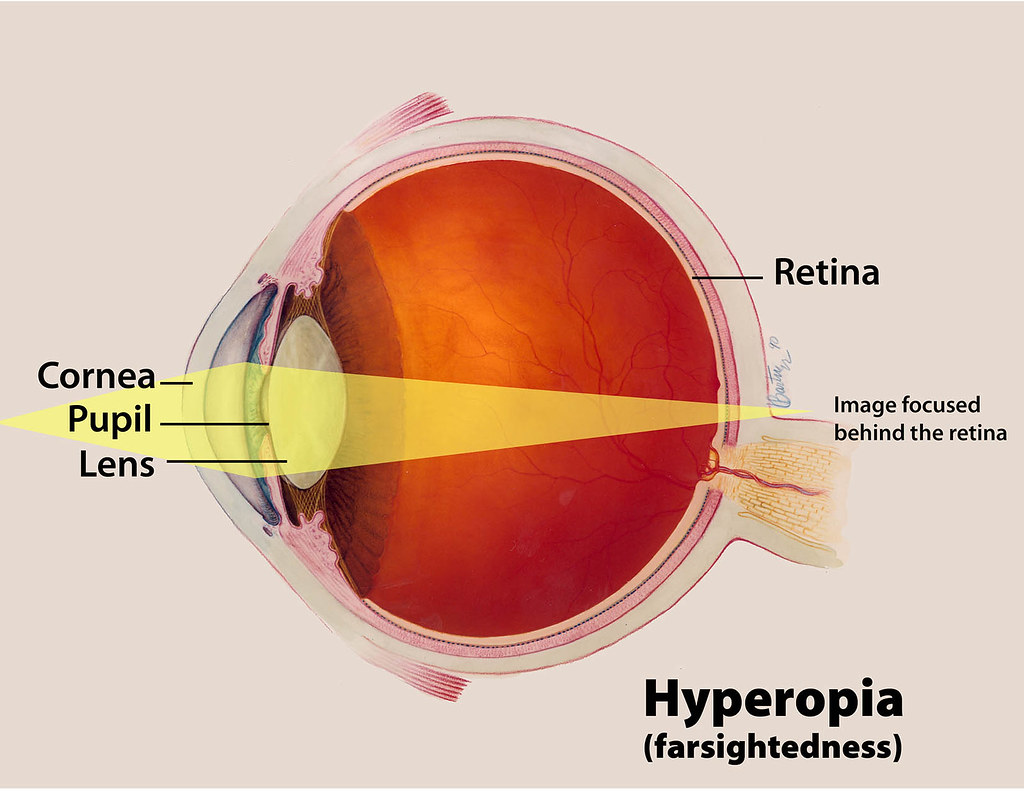Farsightedness, also known as Hyperopia, is a common refractive error that affects the way light is focused on the retina. People with this condition can see distant objects clearly, but nearby objects appear blurry. This vision problem occurs when the eyeball is too short or the cornea has too little curvature, causing light to focus behind the retina instead of directly on it. Understanding the causes, symptoms, and treatments for farsightedness is essential for managing this condition effectively.

What Is Farsightedness?
Farsightedness is a refractive error that impacts how the eyes process light. In a healthy eye, light enters through the cornea and lens, bending to focus precisely on the retina at the back of the eye. The retina then sends signals to the brain via the optic nerve, allowing us to perceive clear images. However, in individuals with farsightedness, the eye’s structure prevents light from focusing correctly on the retina. Instead, the focal point is located behind the retina, leading to blurred vision when viewing close objects.
This condition is often present from birth and tends to run in families. While some people may not notice significant issues with their vision until later in life, others may experience challenges early on. Understanding the underlying mechanisms of farsightedness is crucial for identifying appropriate treatment options.
Causes of Farsightedness
The primary cause of farsightedness lies in the anatomy of the eye. Several factors contribute to this condition:
1. Short Eyeball Length
One of the most common causes of farsightedness is an eyeball that is shorter than normal. When the eye is too short, light entering the eye focuses behind the retina instead of directly on it. This structural difference prevents the eye from properly focusing on nearby objects.
2. Corneal Curvature
The cornea, which is the transparent front part of the eye, plays a critical role in focusing light. If the cornea has insufficient curvature, it cannot bend light effectively. As a result, the light rays do not converge on the retina, leading to blurred vision for close-up tasks like reading or writing.
3. Lens Shape
The lens inside the eye is responsible for fine-tuning focus. In some cases, the lens may not be able to adjust its shape adequately to compensate for the eye’s structural limitations. This inability to adapt further exacerbates the symptoms of farsightedness.
4. Genetic Factors
Farsightedness often runs in families, suggesting a genetic component. If one or both parents have this condition, their children are more likely to develop it as well. While genetics play a significant role, environmental factors and lifestyle choices can also influence the severity of the condition.
5. Age-Related Changes
As people age, the eye’s ability to focus on nearby objects diminishes. This natural decline, known as presbyopia, often occurs alongside farsightedness. While presbyopia typically affects individuals over the age of 40, farsightedness can manifest at any age.
Symptoms of Farsightedness
Farsightedness can present a variety of symptoms, ranging from mild discomfort to significant visual impairment. Recognizing these signs is essential for seeking timely treatment. Common symptoms include:
- Blurred Vision for Close Objects: Individuals with farsightedness often struggle to read books, use smartphones, or perform tasks that require near vision.
- Eyestrain: Prolonged periods of focusing on nearby objects can lead to eye fatigue, headaches, and discomfort.
- Squinting: Squinting is a natural response to improve focus and clarity when vision is impaired.
- Headaches: Persistent headaches, especially after activities like reading or computer work, may indicate uncorrected farsightedness.
- Difficulty Concentrating: Children with undiagnosed farsightedness may find it challenging to concentrate on schoolwork or other near-vision tasks.
- Crossed Eyes: In some cases, particularly among young children, farsightedness can lead to misalignment of the eyes, resulting in crossed eyes or strabismus.
It is important to note that some individuals with mild farsightedness may not experience noticeable symptoms, especially if their eyes can compensate for the condition. However, as the condition progresses or if left untreated, symptoms can become more pronounced.
Diagnosis of Farsightedness
A comprehensive eye examination is necessary to diagnose farsightedness accurately. During the exam, an eye care professional will assess various aspects of vision and eye health. The diagnostic process typically includes:
1. Visual Acuity Test
This test measures how well a person can see at different distances. Patients are asked to read letters or symbols from a chart placed at a specific distance. The results help determine the degree of farsightedness.
2. Refraction Test
A refraction test evaluates how the eye focuses light. Using a device called a phoropter, the eye care professional adjusts lenses to identify the prescription that provides the clearest vision.
3. Retinoscopy
In this test, a light is shone into the eye to observe how it reflects off the retina. This helps the examiner determine whether the eye is focusing light correctly.
4. Slit Lamp Examination
A slit lamp is used to examine the structures of the eye in detail, including the cornea, lens, and retina. This test helps rule out other potential causes of vision problems.
5. Dilated Eye Exam
Drops are used to dilate the pupils, allowing the eye care professional to examine the retina and optic nerve more thoroughly. This step is particularly important for detecting underlying conditions that may contribute to vision issues.
Treatments for Farsightedness
Several treatment options are available to correct farsightedness, depending on the severity of the condition and the patient’s preferences. These treatments aim to improve vision by adjusting how light is focused on the retina.
1. Eyeglasses
Eyeglasses are one of the most common and straightforward solutions for farsightedness. Lenses with a positive diopter value are used to help focus light directly onto the retina. Prescription glasses are customized to meet the individual’s specific needs and can be worn as needed for tasks requiring near vision.
2. Contact Lenses
Contact lenses offer an alternative to eyeglasses and provide a wider field of vision. Like glasses, contact lenses are designed to correct the refractive error by altering the way light enters the eye. There are various types of contact lenses available, including soft lenses, rigid gas-permeable lenses, and multifocal lenses for individuals with presbyopia.
3. Refractive Surgery
For those seeking a more permanent solution, refractive surgery may be an option. Procedures such as LASIK (Laser-Assisted In Situ Keratomileusis) and PRK (Photorefractive Keratectomy) reshape the cornea to improve its ability to focus light. These surgeries are typically recommended for individuals with stable prescriptions and good overall eye health.
4. Orthokeratology
Orthokeratology, or ortho-k, involves wearing specially designed rigid contact lenses overnight to temporarily reshape the cornea. This non-surgical approach can reduce or eliminate the need for glasses or contact lenses during the day. Ortho-k is particularly beneficial for children and adolescents whose eyes are still developing.
5. Vision Therapy
Vision therapy is a structured program of eye exercises designed to improve focusing abilities and coordination between the eyes. While it does not cure farsightedness, vision therapy can help alleviate symptoms such as eyestrain and headaches, especially in children.
Lifestyle Adjustments for Managing Farsightedness
In addition to medical treatments, certain lifestyle adjustments can help individuals manage farsightedness more effectively:
- Proper Lighting: Ensure adequate lighting when performing near-vision tasks to reduce eye strain.
- Regular Breaks: Take frequent breaks during activities that require prolonged focus, such as reading or using digital devices.
- Ergonomic Workspaces: Position books, screens, and other materials at an appropriate distance to minimize discomfort.
- Eye Exercises: Simple exercises, such as focusing on distant objects and then shifting focus to nearby ones, can help maintain eye flexibility.
Conclusion
Farsightedness is a common condition that affects millions of people worldwide. By understanding its causes, recognizing its symptoms, and exploring available treatments, individuals can take proactive steps to manage their vision effectively. Whether through corrective lenses, surgical interventions, or lifestyle modifications, there are numerous ways to address this refractive error and improve quality of life.





